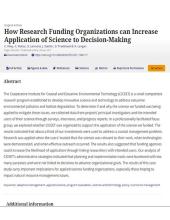
Abstract
The Cooperative Institute for Coastal and Estuarine Environmental Technology (CICEET) is a small competitive research program established to develop innovative science and technology to address estuarine environmental pollution and habitat degradation. To determine if and why the science we funded was being applied to mitigate these issues, we collected data from projects ’ principal investigators and the intended users of their science through surveys, interviews, and progress reports. In a professionally facilitated focus group, we explored whether CICEET was organized to support the application of the science we funded. The results indicated that about a third of our investments were used to address a coastal management problem. Research was applied when the users ’ trusted that the science was relevant to their work, when technologies were demonstrated, and when effective outreach occurred. The results also suggested that funding agencies could increase the likelihood of application through linking researchers with intended users. Our analysis of CICEET's administrative strategies indicated that planning and implementation tools were burdened with too many purposes and were not linked to decisions to advance organizational goals. The results of this case study carry important implications for applied science funding organizations, especially those hoping to impact natural resource management issues.
About this article
This 2011 journal article, published in Coastal Management, analyzed survey, interview, and progress report data to determine if and why the science generated by funded projects was being applied to mitigate coastal management issues.
Riley, C., Matso, K. E., Leonard, D., Stadler, J., Trueblood, D., & Langan, R. (2011). How research funding organizations can increase application of science to decision-making. Coastal Management, 39(3), 336-350. https://doi.org/10.1080/